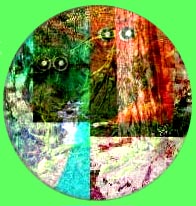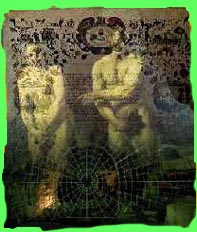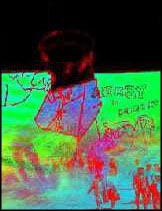Adam[i]n Paradise
Joel Weishaus

In April 2005, Geert Dekkers posted a drawing on the Internet that reminded me of the work of Italian artist Valerio Adami.
“In his early Pop-related works, he offers us views of isolated fragments of modern society in which objects are taken out of perspective and context to allow us to see them anew. These are largely sleek designs—visions of a world with no visible signs of life in it. They were succeeded by a number of works focusing on historic moments and presentations of such heroes of modern culture as Walter Benjamin, Freud, and Joyce, often evoking rather ruefully the world they desired but failed to create.”
Decades had passed since I’d come across H. Damisch’s and H. Martin’s book, Adami, followed by Jacques Derrida’s essay on Adami, “+R (Into the Bargain).” As I re-read these texts, obvious wordplay, such as
Adam: "The first man in his turn" (P. Ricoeur)
Adami: "Son of Adam" (Latin, genitive case)led me to the environs of Paradise, and to reassessing the archetypal prevalence of the Garden of Eden and the Adamic Myth.
Fossilized footprints eroded by floods, shreds of leaves & twigs, roots uprooted from weathered mnemonic horizons, finally, the basic vocabulary of tectonic forms in which the modifications are resolved—flat cuts, cubical volumes, geometric reliefs—is the vocabulary best known to a race of constructors, and, at the same time, the Gods, updated, turn to their receptors, the myths sink in.Dreamed of a large painting, a pastoral scene absent of animal life
hanging in a well-lighted room. When the lights dimmed, another
picture appeared, one with ultraviolet animals in three dimensions.Rejecting a garment of light, he clothed himself in the skin of a serpent. A fall from grace, or a coming-of-age story? Adam is 'adamah, a man of the earth, made from the best of the earth, risen from its navel, he drains and pollutes it, before becoming it again. An inevitable sacrifice, from beginning to fulfillment? "In the legends of the Jews and in Talmudic commentaries (especially in later periods) the tradition of a primal androgynous being is preserved. For example, Rabbi Jeremiah ben Eleazar said, 'Adam was doublefaced, since it is said, "'Thou hast made me behind and before.'"" One face was male, the other female. Adam was a man with questions.Even in Paradise Adam's naming of the creatures is connected with his birthright of dominion over them.
As the work of Jefferson and Audubon in the American Eden attest, the taxonomic and the taxidermic are kind-
red impulses. Jefferson, experimenting with cosmetic surgical techniques for survival movement, stay of death
[arrêt de mort, also 'death sentence'], final trance, arched leap held on the bit. Caught in the links or the
angled scales of ichthys, like Adami's signature, or rather his acronym, for evisceration, with niter and pepper
as preservatives for stuffing animals; Audubon, with a long needle piercing the heart of a caged eagle the better
to pose it for painting. Nature morte. The danger is this: to name is to capture; to preserve is to kill.
| In taxonomics everything
is implicated,
everything is complicated, everything is sign,
meaning, essence.
Everything exists in those obscure zones that we penetrate as into crypts, in order to decipher hieroglyphs and secret language, classification and categorization are strategies of control over the Other. Blurring origination, too, is a method of domination: "My god created the world." In Adami's
paintings, borders are breached and language flows, as Adam
is born an
artist; he does not have to grow into the aptitudes |
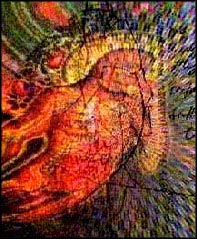 |
I could have been this man.
I could have his shadow.Planned his escape carefully. Stashed his manuscripts behind a knob of the Tree. Packed a rucksack full of wormy apples. Donned his one warm suit and shoes meant the multiplicity of substances which were poured or placed into the vessel at the beginning of the opus were lead, vinegar, salt, quicksilver, iron, blood, poison, hair, sulpher, milk, wine, urine, dung, or a chaotic concoction of material for the streets of Paris. Trekked over high mountain passes, fascist boots crushing the path not far behind.
At the border he signed
he would not be
and was told, a Jew,
allowed to cross.The mind,
fast as it goes, losespace, puts in place of it
like rocks simple markers,
for a way only to
hopefully come backwhere it cannot.
He wrote, the painter's products stand before us as though they were alive, but if you question them, they maintain a most majestic silence. It is the same with written words: they seem to talk with tears falling behind farsighted eyes, "We meet only to part."Overdosed on morphine—
there is no record of
the name of God, the form of living discourse,
in jumbles of letters that do not make sense,
these texts show that it is really ordinary writing
that is scrambled and confused, a mere imitation
of what happened next.
Climbing the stone steps, rib cage stretching beyond its pale, Adam's satisfaction with the creation of Eve would have been expressed in his heart and that, in naming the animals, rather than speaking (in the usual sense of the word), Adam was laying down the rules of language and thus I feel the pleasure the Tree of Knowledge had as it walked out of Eden.
Now the myth (in which the woman appears as the seductress of the man by giving him the apple to eat) is probably a miserable, tendentious distortion by an invisible presence, beautiful to behold, concealed in the foul-smelling sludge which fills the apparatus each night, and Freud realized that the task of the Dreamworker is to free this being from the useless prima materia of dreams, the decaying corpse of a priest’s apprentice who, as we know now condensed in a quite witless fashion (as in a dream) two independent sources into one account.
We've tracked the emergence of homo sapiens at least 200,000 years back, to Africa and the so-called "mitochrondrial Eve." While in Genesis, before Adam could find his tongue, Adami likes to recall a certain comment by Valery quoted by Walter Benjamin which speaks of poetry becoming so cloudy that it becomes confused with a cloud (in the same way that one kind of psychoanalysis makes such a confused idea of the unconscious that it becomes confused, so, Eve addressed the Serpent: Yes, it is I, "laying down the first rules of language, and thus performing a metalinguistic act." Not sin, but grammar; the Apple is in the I.
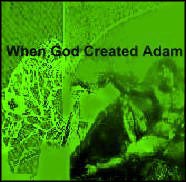
He gathered dust of four colors,
from the four corners of the world:
of red He created blood,
of black He created entrails,
of white He created bones,
of green He created the body.
The Apple was of a greenish hue, with thousands of impure spirits fluttering round who all wanted to get into him. But God shooed them away till only one remained, Lilith, the 'mistress of spirits,' who succeeded in so attaching herself to Adam's body that she became green.
Do we still need the Garden? Or would a peaceful park in the heart of the city do? Arbors, grottoes, caves, groves, hedges, the topography of Eden is an iconography that still haunts us, for the soul cannot grasp anything that is not converted into a sequence of phantasms; in short, it can understand nothing without a lively place where the Other is not penned, or pinned down.Genesis does not indicate that Adam dreamt during his deep sleep; and this is significant since it is important to imagine Adam's sleep as being a sleep without mind, a stupor that exists where mind one day might be.
'Or what we see is no more a part of
us than the baby who beckons from the
forest: we splinter in the void to catch
the light, then hail the sparks as paradise.'
too tall to remember
the Separation of the Primordial Unity
is a mythologem that usually appears
after the epiphany of the Creator God
or Goddess, but sometimes before.
The primal separation must take place before anything further can occur.
It is the first step in organizing
their roots.
Last night I dreamed that a surgeon removed a fish from one of my lungs. Shifting planes of perception occur simultaneously.If there is one word that interests me,
it is the word
simultaneityWe are hooked on depths impossible to plumb through linear time.
After negotiating the "depths and distances," with “stumblings and slips of the tongue," he finally left Vienna. An anxious trip on the Orient Express brought him to the border, crossing into France without incident, although Adami drew him with an ice pick in hand. He arrived in England by boat the next day. In his first letter from London, Freud wrote, "one had still very much loved that God had originally ‘inscribed’ his law upon Adam’s heart; that the Fall had ‘erased’ or otherwise compromised this interior law; and that God had compensated Adam’s descendents for this loss by offering them the prison from which one has been released."
A year later, the man known for "the talking cure" died from cancer of the mouth.
Well, Adami's finish was lethal. It excluded every sign of life as improper or unclean. He was presenting a world that had just died. The work of that period showed that behind the figure of the serpent shimmers another form still reflecting its former life. A tension exists because this independent life of the original figure still struggles against the framework of a simple snake into which everything human—mental activity, free will, encounters with the unknown, everything that takes place on the borders, at the horizon, everything that demands distance—was now absent. His 'design' severity called forth the memory of a forgotten grace. 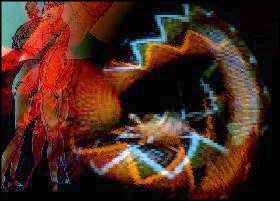
Tonight, my legs I noticed an old scar on a shin bone, then, we shall not say, “the story of the ‘fall’ is only a myth---that is to say, something less than history---but, ‘The story of the fall has the greatness of myth’---that is to say, has more meaning than a true history left by a gray cable I jackknifed over in twilight.
The cords of all link back…cable of all flesh…Will you be as gods?
Gaze in your omphalos. Hello…Put me on to Edenville. Aleph, alpha:
nought, nought one. Spouse and helpmate of Adam Kadmon: Heva,
naked Eve. She had no navel.Adam sprang like a fish jerked into an alien world—no entrance, no memory of the long mythological cast. Nor could he remember his thoughts upon the sudden appearance of monstrous images and bestial forms, including, perhaps, the man-eating nature of God himself (no mirror). Nor did he recognize the voice that said, "Welcome to the world I created."
The owl appeared as if sprung
from a world beneath to the limb of a nearby tree.
He swiveled his head and looked at me:
not a word was exchanged. Now I understood
what Nietzsche meant by “All our so-called consciousness
is a more or less fantastic commentary upon an unknown text,
one that is perhaps unknowable, but still felt.”In the woods behind my family’s summer bungalow, a large rock jutted from the earth with an opening in its side just large enough for a skinny boy to crawl through. One sharp turn and I entered a chamber high enough for me to sit up. There bone symbolizes the final root of animal life, the mold from which the flesh continually arises. It is from bone that men and animals are reborn. After their life is reduced to the essence concentrated in the skeleton or some bone ‘they are revivified’; that is, the skeleton in a crevice was a stiff sheet of parchment with words written in a language I didn't understand. When I touched it, it burned my fingers. Frightened, I backed out and wiped its memory from mind, except in dreams, as if in seeing that strange text I had committed a mortal sin.
Recently, after reading of the Book of Secrets, given to Adam upon his exile from Eden, the only known book prepared in Heaven that existed "and still does, in fragments, on the earth," I dreamed of the cave in the Catskill Mountains, and woke to the humor of a mystical Hebrew text secreted in the heart of the Jewish comedic circuit.
In Adami's paintings, "what’s inside is inside and what’s outside is outside and there is no question of confusing inside and outside, art and life, a mental event with a clear conscience since we have discovered some basic and significant analogies between the myth of Adam and the puberty rites (of primal peoples). Some features of an early tradition from which the Biblical account originated came to the surface in our own analytic reconstruction in spite of all secrecy and distortion. Adam’s deep sleep, the rib operation, the union with a woman and the new name (Is.Heb.:Man) must now be understood as survivals of the old and suppressed tradition and phenomenal events on the basis of the almost negligible perception that part of the equipment of the former consists of images or proxies of the latter."
In Ice Age caves it's not the corpus of animals we see but how they moved, and therianthropic figures in ecstatic flight. "The use of hallucinogens goes back to the Paleolithic Period and that their use always takes place within contexts and rituals of a mystico-religious nature." To track Reik's theory that the Adamic Myth is a survival from primal initiation rites would mean that psychedelic plants grew in Eden, so that then Adam would have seen God walking crawling, leaping, flying, swimming...Riverrun, past Eve and Adam’s. from swerve of shore to bend of bay.
A morning of scudding clouds. At the Rose Garden tourists are launching a thousand conversations, children clutching the possibility that our brains are connected, or entangled, with everything. In which case we can think of psychic phenomena not as a mysterious process of information being sent from one place to another and somehow getting into your head, but more as a change of attention with parents' fingers as if long-stemmed roses. Before children were, Adam blossomed, or so it seemed.
Freud is on his way to London to die; Benjamin crosses still another frontier only to commit suicide. Adami's reductive system of lines has dared to take the step that leads to the detachment of consciousness from the object; he has freed himself from attachment, entanglement, and delusion, and can therefore turn homeward. He gives us more than a subjective expression of personal opinion, for the creative genius is never one but, his sectionalizations, which eclipse content, narrative, and depth, entrap in, and reduce these thinkers' lifelong meditations to a single, philosophically negligible, incident.
I reach Adam and Eve,
nothing is seen anymore, it’s dark.
Now my nonexistence dies already
with the trite death of mathematical fiction.
As trite as the death of my existence would have been
had I been really born.
A leaf falls, already yellow and brittle in early September. Sun illuminates the perfection of a spider’s web strung between trees. Was it ever really this way: the silence; the sound of a waterfall; birds pecking at gravel for seeds?
How long did it take before Adam suspected that while Eden was "perfect" everything in it, including himself, was only "in process of the realization of perfection," and that remaining there would lead to "a condition of self-nurturing despair."? Did he decide to eat the apple even before Eve offered it, engaging in "the symbolic parricide without which none of us can become totally adult.”? We now know that some Church leaders at the Council of Trent called for the suppression of the Bible itself, which was to be encountered only through approved commentaries. What would a civilization be like in which a cabal makes spiritual decisions for us before we are aware of them (?)
Riverruns parallel to a path.
For most of the way I hear
the low
bellow of trains
by the docks below.Having relaunched Ulysses, following "the curve of what we might call the symbolic narrative of kabbalistic travel," Joyce fled France with the Fascist Wrath at his heels, arriving at the train station in Geneva "in the shadow of a wintry twilight, his face very pale, aged, marked by fatigue. He advanced through the crowd, which his tall figure dominated, holding onto his wife’s arm is not instruction in the modern sense, but presentation of the tribal myths, the story of supernatural beings and of mythical ancestors---of how the world was created like a blind man;" like Adam—
Where do we go from Here?.
A note on the making of this text, with reference to Adami, who "wishes to emulate the prose poem, the kind of text that defies homogeneity, that unites contrasting elements, and that features verbal experimentation with space and time. He keys into narrativity, no longer definable as a story arising from elements, but as a profile unexpectedly traced in the pursuit of form."
References
In his early Pop-related works: http://spaightwoodgalleries.com/Pages/Adami.html
+R (Into the Bargain): J. Derrida. The Truth in Painting. Chicago, 1987.
finally, the basic vocabulary: C. Paternosto, The Stone and the Thread: Andean Roots of Abstract Art. Austin., 1996.
in the legends of the Jews: T. Reik, The Creation of Woman. New York, 1960.
Even in paradise: D.Weiss, "Refusing to Name the Animals." Gettysburg Review, Winter 1990.
survival movement: Ibid, J. Derrida.
everything is implicated: G. Deleuze, Proust and Signs. Minneapolis, 2000.
Adam is born an artist: E. Rhode, The Generation of Adam. London, 1990.
I could have been this man: E. Jabès,The Book of Questions. Middletown, CT., 1984.
the multiplicity of substances: R. Severson, "The Alchemy of Dreamwork: Reflections on Freud and the Alchemical Tradition." Dragonflies, Spring, 1979.
The mind / fast as it goes:R. Creeley. From, "I Keep To Myself Such Measures."
the painter's products: Socrates. In, Plato's Phaedrus..
the name of God: P.C. Miller, The Poetry of Thought in Late Antiquity. Aldershot, 2001.
Adam's satisfaction: U. Eco, "Languages in Paradise." Serendipities: Language and Lunacy. New York, 1998.
Now the myth: A. Freud, May 25, 1938. Quoted in, P. Gay, Freud: A Life for Our Time. New York, 1988.
by an invisible presence: Ibid, R. Severson.
Adami likes to recall: H. Martin. In, H. Damisch and H. Martin, Adami. New York, 1974.
laying down the first rules: Ibid, U. Eco.
When God Created Adam: Adapted from, L. Ginzberg, Legends of The Jews. Philadelphia, 1975.
of a greenish hue: C.G. Jung, Mysterium Coniunctionis. Collected Works, Vol. 14. Princeton, 1976.
for the soul: I.P. Couliano, Eros and Magic in the Renaissance. Chicago, 1987.
Genesis does not indicate: Ibid, E. Rhode.
Or what we see: C. Bernstein. From, "Lost in Drowned Bliss." In, World on Fire. Vancouver, 2004.
the Separation of the Primordial Unity: J. Singer, Androgyny. Garden City, NY., 1977.
If there is one word: V. Adami. Ibid, H. Damisch et al.
We are no longer quite here: A. Freud, May 25, 1938. Quoted in, P. Gay, Freud: A Life For Our Time. New York, 1988.
depths and distances: R. Duncan. From, “Narrative Bridges for Adam’s Way.” In, Bending the Bow. New York, 1968.
stumbling and slips: Ibid, H. Damisch and H. Martihn.
that God had originally: E. Jager, The Tempter’s Voice: Language and the Fall in Medieval Literature. Ithaca, NY., 1993.
Well, Adam's finish was lethal: J-F Lyotard and M. Lydon, "It's As If a Line..." Contemporary Literature. Autumn 1988.
behind the figure: B.S. Childs, "Myth and Reality in the Old Testament." Studies in Biblical Theology. (1960).
then, we shall not say: P. Ricoeur, The Symbolism of Evil. Boston., 1967.
The cords all link back: J. Joyce. Finnegans Wake. New York, 1939.
monstrous images: Ibid, P.C. Miller.
All our so-called consciousness: F. Nietzsche, The Dawn of Day. New York, 1974.
bone symbolizes: M. Eliade, Birth and Rebirth. New York, 1958.
and still does: G. Yarchison, World of Angels. New York, 1983.
what's inside is outside: Ibid, H. Damisch and H. Martihn.
with a clear conscience: Ibid, T. Reik.
The use of hallucinogens: G. Samorini, "The Oldest Representations of Hallucinogenic Mushrooms in the World." Integration, Vol. 2/3, 1992.
Riverrun: J. Joyce. Finnegans Wake. New York, 1939.
the possibility that our brains: D. Radin. Quoted in C. Hamilton, "Is God in Your Head?" What Is Enlightenment? June-August 2005.
Freud is on his way to London: R.R. Hubert, "Derrida, Dupin, Adami: 'Il faut être plusieurs pour écrire.'" Yale French Studies 84, 1994.
has dared to take: C.G. Jung, “Ulysses: A Monologue." The Spirit in Man, Art, and Literature. Collected Works Vol. 15. Princeton., 1978.
I reach Adam and Eve: A. Swir. From, “Woman Unborn.” C. Milosz and L. Nathan, translators.
in process of the realization: W.S. di Piero, Out of Eden: Essays on Modern Art. Berkeley, 1991.
the symbolic parracide: F. Du Plessix Gray, "Charles Olson and an American Place.” In, K. Erikson, Editor, Encounters. New Haven,, 1989.
some Church leaders: R.B. Ray, The Avant-Garde Finds Andy Hardy. Cambridge, MA., 1995.
the curve of what we might call: J.I. Cope, Joyce's Cities: Archaeologies of the Soul. Baltimore,,1981.
in the shadow of a wintry night: J. Marcanton, "The Hours of James Joyce.” In, W. Potts, Editor, Portraits of the Artist in Exile: Recollections of James Joyce by Europeans. Seattle, 1979.
is not instruction: Ibid, T. Reik.
A note with reference: R.R. Hubert, "Derrida, Dupin, Adami: 'Il faut être plusieurs pour écrire.'" Yale French Studies 84 (1994).Joel Weishaus
IX:2005 Rev. 2013.

